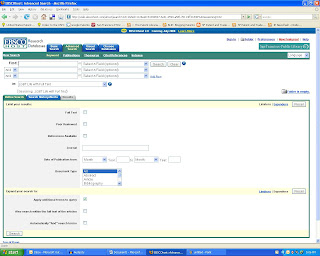
Here in the
Magazines and Newspapers Center, we see people every day who are using news sources to research just about any topic you can imagine, and with good reason. Books are a great way to get into a subject, but many researchers rely on the contemporary perspectives more commonly found in magazines, newspapers, newsletters, and periodicals for insight into the social, political, historical, and cultural context of the times and people that produced them.
The (fairly) recent acceptance of blogs and other new media as valid sources for news and political information is a reminder that we cannot always rely on major news outlets for a complete story. There are so many different perspectives out there that you can't rely on the
New York Times and
CNN to pick up everything. In addition, there are certain standards of journalistic objectivity that often prevent writers from interjecting their own experiences and identities into their work; sometimes, that perspective is just the thing to help a researcher capture the
zeitgeist of a given time period.
There's a whole world of reporting and commentary that falls outside what we may consider the mainstream, including small press journals, independent newsletters and zines, and other publications representing the perspectives of different groups within the greater society. Here at the
San Francisco Public Library, we have some tools to help you access these considerable resources:
The
Alternative Press Index and the Alternative Press Index Archive represents a huge amount of independently published writing. This index has covered hundreds of publications for almost four decades. The focus here is radical politics, feminism, indigenous peoples, labor, and other topics generally on the left side of the political spectrum. The index is updated quarterly. Many titles link to our library holdings, and many can be found in the
Underground Newspaper collection.
Ethnic Newswatch pulls
articles from small press ethnic and minority publications. Find perspectives of various ethnic groups including African American, Arab American, Asian American, Eastern European, Jewish, Native American, and other multi-ethnic groups. Coverage goes back to 1960 and includes full-text access.
GenderWatch includes
literature relating to LGBT studies, Women's Studies, Gender Studies, and Family Studies. While many of the titles are academic, there are also news and popular culture titles such as
Off Our Backs and
The Advocate. Includes indexing, full-text access, and coverage back to 1970.
LGBT Life is another database that features news and popular culture titles alongside more academic offerings. The focus here is on
LGBT titles, with a few dozen titles comprehensively indexed and a couple thousand more indexed selectively. Articles are available full-text; historical coverage dips back into the 1950s!
Access to these databases is available through our Articles and Databases list. Here's a quick run-down of how to get to them:
1. Go to the
SFPL Home Page and select “
Articles & Databases.” You will need a
San Francisco Public Library card to access the databases from outside the Library.
2. At the top of this page, click on "
Alphabetical List."
3. Scroll down the list and connect to the title of your choice.
Remember, you may not be able to get immediate online access to that perfect article you find in one of these databases. If you find an article that you'd like to read but you can't find a copy, get in touch with the
Magazines and Newspapers Center. We'll be happy to help you find a way to get a copy.
 America’s birthday ignited with a bang over 200 years ago, and this annual commemoration continues to this day with dazzling displays of fireworks showering over the sky punctuated by the rapid artillery of firecrackers. The 4th of July marks this nation’s freedom from the British monarchy which started with a document drafted by the forefathers of this nation.
America’s birthday ignited with a bang over 200 years ago, and this annual commemoration continues to this day with dazzling displays of fireworks showering over the sky punctuated by the rapid artillery of firecrackers. The 4th of July marks this nation’s freedom from the British monarchy which started with a document drafted by the forefathers of this nation.

